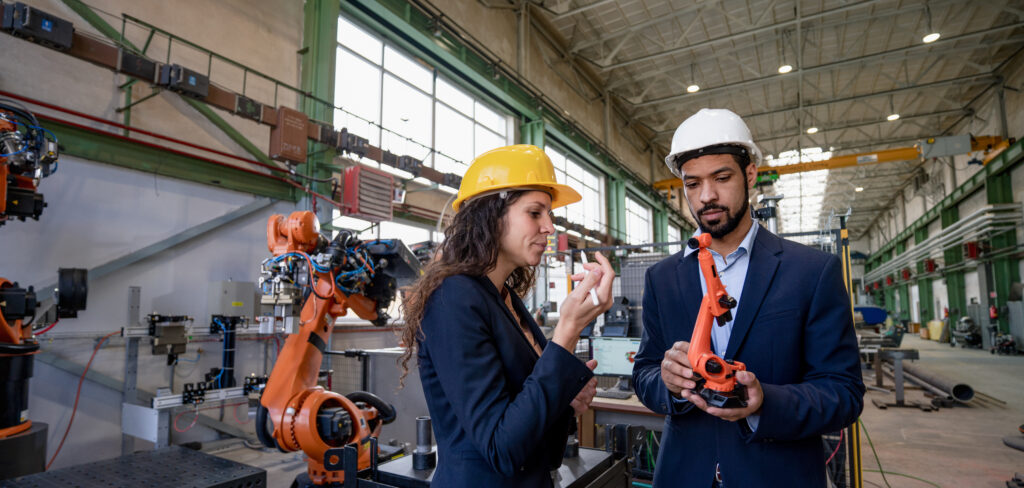The advent of Industry 4.0 has revolutionized the manufacturing sector, introducing a new era of interconnected workforce. This shift is not merely a technological upgrade but a complete transformation of how manufacturing operations function. Digital tools like FAT FINGER are playing a pivotal role in this transformation, offering solutions that streamline operations, enhance safety, and foster a culture of continuous improvement.
The Rise of Industry 4.0 and Its Impact on the Manufacturing Workforce
The transition to a more digital, automated, and interconnected industrial environment demands a significant shift in skills, mindset, and organizational culture. This next section, “Adapting to the New Era of Manufacturing,” explores how Industry 4.0 is reshaping the roles, skills, and training of workers, highlighting the critical need for adaptability and continuous learning in the face of rapid technological advancements.
Adapting to the New Era of Manufacturing
Industry 4.0, characterized by the integration of digital technologies like the Internet of Things (IoT), artificial intelligence (AI), and robotics into manufacturing, is changing the landscape of the industry. This revolution is leading to a more connected, efficient, and responsive manufacturing process, necessitating a workforce adept in new technologies and adaptable to change.

Workforce Transformation in Smart Factories
Smart factories, the hallmark of Industry 4.0, demand a workforce that is not only tech-savvy but also capable of working seamlessly with advanced machinery. This transformation is creating new roles and career paths, focusing on skills in data analytics, machine operation, and digital proficiency.
FAT FINGER: A Catalyst in Digital Transformation of Manufacturing
As we explore the pivotal role of digital solutions in modernizing the manufacturing sector, it becomes evident that specific platforms stand out for their transformative impact. One such platform is FAT FINGER, which has emerged as a catalyst in the digital transformation journey of many manufacturing entities. By leveraging FAT FINGER’s innovative features, manufacturers are not only embracing the digital age but are also setting new benchmarks in operational efficiency.

Enhancing Operational Efficiency
FAT FINGER is empowering smart factories to achieve unprecedented levels of productivity, reliability, and agility, marking a significant leap towards the future of manufacturing. This digital workflow builder enhances operation efficiency by providing real-time monitoring, predictive maintenance, and efficient resource management, enabling manufacturers to optimize production and reduce downtime.
Enhancing Safety and Compliance
Prioritizing safety and compliance, FAT FINGER helps in maintaining high safety standards in the manufacturing environment. By digitizing safety protocols and automating compliance processes, this no-code workflow builder ensures a safer workplace aligned with Industry 4.0 objectives.
Navigating Integration and Compatibility Issues
Integrating new digital tools with existing systems presents challenges in terms of compatibility and seamless operation. FAT FINGER’s flexible and scalable solutions address these challenges, ensuring smooth integration with various manufacturing systems and processes.
Bridging the Skills Gap in the Workforce
The shift towards an interconnected workforce creates a skills gap that needs addressing. FAT FINGER supports this transition by offering intuitive interfaces and training resources, aiding the workforce in adapting to and excelling in a digitally advanced manufacturing environment.

Implementing Machine-to-Machine and Machine-to-Human Interactions
In the interconnected manufacturing setup, machine-to-machine (M2M) and machine-to-human (M2H) interactions are pivotal. FAT FINGER facilitates these interactions by integrating IoT devices and smart systems, enhancing communication and collaboration on the manufacturing floor.
Data-Driven Decision Making and Predictive Analytics
Data analytics and predictive modeling are central to Industry 4.0, enabling manufacturers to make informed decisions and anticipate future challenges. FAT FINGER’s analytics tools provide insights into production processes, helping manufacturers to optimize operations and minimize risks.
Conclusion
The interconnected workforce, driven by the advancements of Industry 4.0, is setting new standards in the manufacturing industry. Tools like FAT FINGER are at the forefront of this transformation, enabling manufacturers to embrace digitalization effectively. As the manufacturing sector continues to evolve, the integration of digital tools will be critical in maintaining a competitive edge in the global market.


